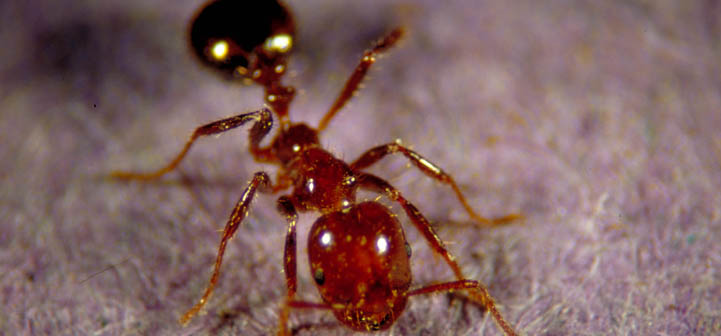Persistent cold snaps in many traditionally mild areas of the U.S. have prompted questions concerning Imported Fire Ant endurance in the frigid winter weather.
It’s difficult to expose fire ants to lethal temperatures because they move within the mound to avoid temperature extremes. When temperatures drop, fire ants move deeper into the warmer soil below the surface to avoid the cold. However, if the temperatures drop rapidly they may not be able to avoid the cold, especially if wet soil prevents them from moving deeper in the mound.
Extension Entomologist Kathy Flanders says the northern extent of the fire ant distribution in the United States depends largely on winter temperatures. “Fire ants can’t survive in conditions where the soil freezes as deep in the ground as the ants are nesting,” she says. “Such a freeze is possible only on the northern fringes of the fire ants’ geographic distribution.”
Persistent cold temperatures are required to impact fire ant populations. For example, during the 1990s in Tennessee, five consecutive days when the air temperature did not exceed 34 degrees F resulted in a significant proportion of dead colonies. According to Karen Vail, Extension Urban Entomologist at the University of Tennessee, in the first six weeks of 2014, twice there were three consecutive days during which air temperatures did not exceed 34 degrees F. So far, this area hasn’t experienced the continuous cold temperatures needed to cause widespread death of fire ant colonies.
Fire ants die quickly when exposed to temperatures in the teens or lower. At 12 inches below the surface, the coldest temperature logged thus far in 2014 at the University of Tennessee Trial Garden’s weather station in Knoxville was 37 degrees F. Ants located at this depth haven’t experienced lethal temperatures yet.
Cold impacts on fire ant populations are localized. Fire ant mounds located near homes and other heat sinks will be protected from the colder temperatures to some extent.
Even if some colonies die, others will survive. Over time, under optimal conditions, population densities will rebound to pre-existing levels or larger.
“In extreme cold conditions fire ants aren’t visible, but that is a perceived lack of activity,” says Texas A&M AgriLife Extension Program Specialist Dr. Paul Nester.
A drop in visible activity does not always mean a decreased population. On warmer days after the recent cold snap, dead fire ants workers were found on the top of mound indicating some ants had survived to move the dead ants out of the colony. When the weather warms again in the spring, it will be important to continue to scout for mounds. Problems arise when the perceived drop in population causes population management to cease.
For more information about the effects of temperatures on Fire Ants, check out the two FAQ questions on eXtension.org here and here. For more information about Imported Fire Ants visit eXtension’s Imported Fire Ant page.
